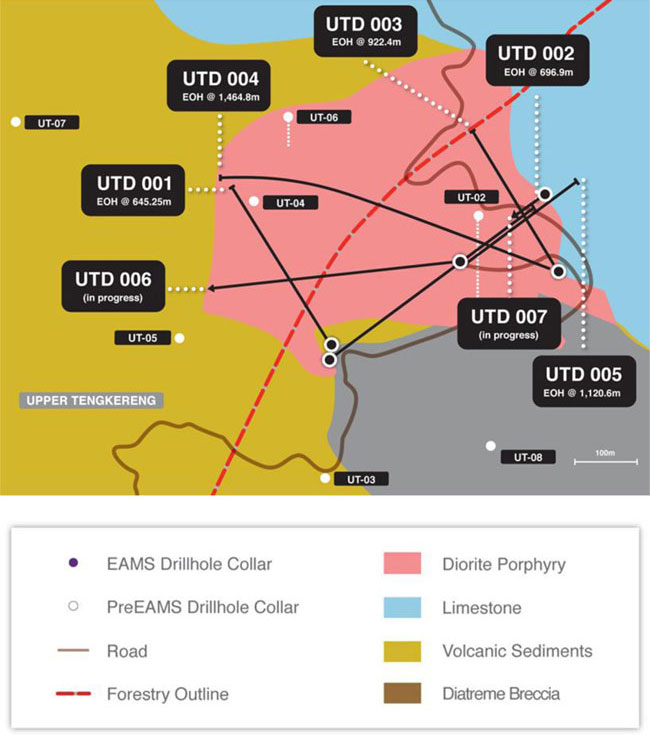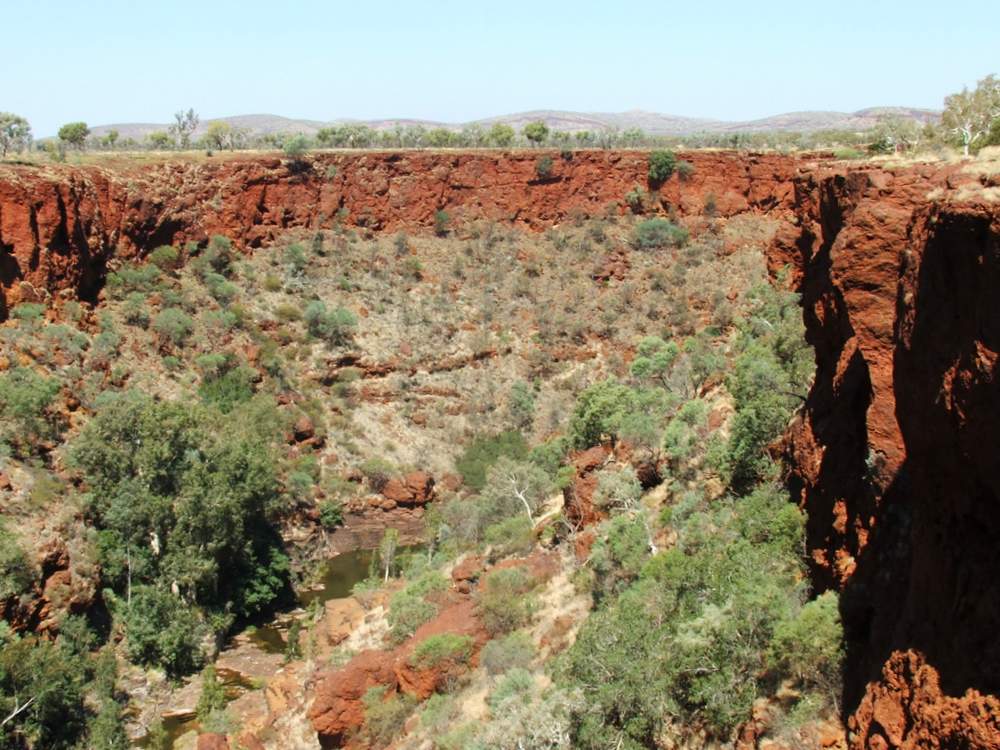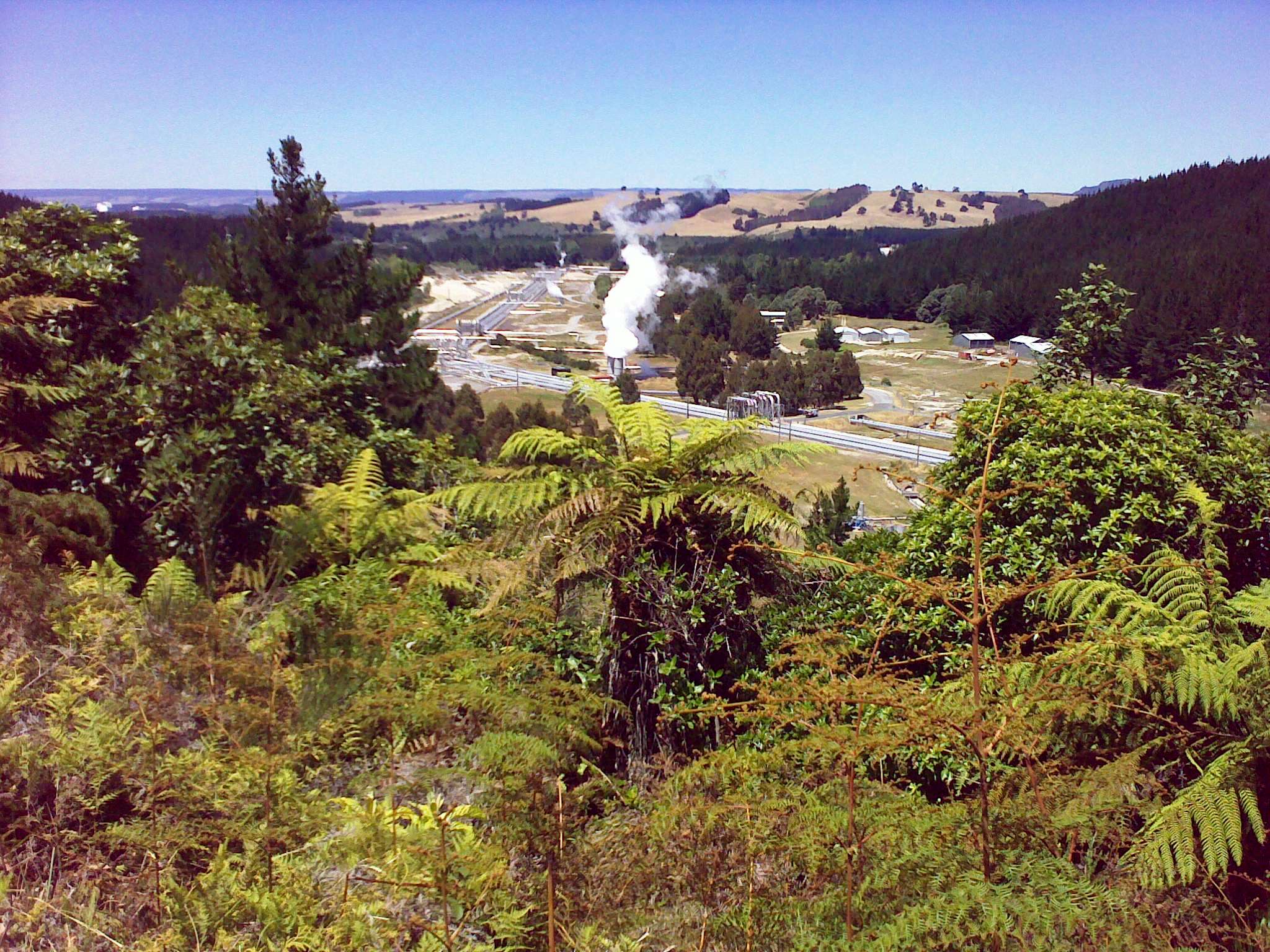With almost 600 meters of gold values, the results from hole UTD-006 certainly help create a case in favour of continued work on the Upper Tengkereng gold-copper deposit. Its hardly “high grade”, but gold is gold. The company’s task will be to trace and define the higher grade intervals.
[box type=”info” align=”aligncenter” ]Disclaimer: This is an editorial review of a public mining company press release and is not an endorsement. It may include opinions or points of view that may not be shared by the companies mentioned in the release. The editorial comments are highlighted so as to be easily separated from the release text and portions of the release not affecting this review may be deleted. Read more at How to Use this Site.[/box]
VANCOUVER, BRITISH COLUMBIA–(Marketwired – May 12, 2014) – Barisan Gold Corporation (TSX VENTURE:BG) is pleased to announce that drilling at hole UTD-006 has confirmed the presence of a second distinct high-grade zone located in the south-central part of the Upper Tengkereng gold-copper porphyry discovery, located in the Province of Aceh, Indonesia.
[box type=”note” align=”aligncenter” ]
Here’s a general overview of the Barisan Porphyry Belt from earlier this year.
[/box]
Assays have been received from the first 600 metres of hole UTD-006, which confirm the existence of a second high-grade zone. From 142 to 414 metres, UTD-006 returned 272 metres of 0.6 g/t gold + 0.6% copper (1.0% copper equivalent at current market prices) within a wider intercept of 458 metres of 0.6 g/t gold + 0.5% copper (0.9% copper equivalent at current market prices). This new high-grade zone remains open down hole and is anticipated to return meaningful grades until at least the 730-metre mark in length.
[box type=”note” align=”aligncenter” ]
Headlines like “458 metres of 0.6 g/t gold + 0.5% copper” a few years ago would cause a few heads to turn. But given the current state of the mining industry, it may take a lot more than some promising results to push this copper-gold porphyry to feasibility. Barisan Gold (TSX: BG) is a junior mining company actively exploring “The Barisa Porphyry Belt” in North Western Aceh Province, Indonesia. Since we last talked about Barisan, the company has initiated drilling on the Upper Tengkereng property following up on previous work by previous owner East Asia Minerals company. Over the past eight months Barsian has completed 5 deep exploration holes to test the extent of mineralization within the prospect. When drilling began Barisan Gold was trading on a 52 week high of $0.445, but since the beginning of April the stock has declined by 68%. This likely has more to do with current global sentiment than Barisan since results from the drill program have been generally good.
Below is a plan view map outlining the extent and location of drilling currently taking place on the Upper Tengkereng property.
[/box]

[box type=”note” align=”aligncenter” ]
While this project is still in early exploration stage and many more holes will be needed before the company can declare a resource, investors should be thinking about possible obstacles that may need to be overcome if the project proves to be economic. In 2012 the Ministry of Energy and Mineral Resources (MEMR) in Indonesia issued Regulation No. 7. This ruling prevented the export of raw minerals and requires all materials to be refined at a standard outlined by MEMR within Indonesia. Even if Indonesia has the refining capacity to meet demands, future development of economic deposits may strain or exceed the country’s refining capacity. There are exceptions for some metals where full refining is not required. Copper, manganese, lead, zinc, and iron have a 3 year grace period where they can be exported as concentrate (fine material) and are not required to be fully refined. Barisan is aware of this issue and stated in their NI 43-101 filed in February 2013, that this ruling “may affect the potential future development of any porphyry deposit.”
If Barisan Gold advances the project to pre-feasibility stage and establishes some positive economics, the company will need to find a buyer that could ensure access to a local smelter. This could limit the pool of potential suitors.
Of course, rules can change and political decisions in one country can effect mining projects on the other side of the world. Indonesia’s recent ban on nickel exports is a prime example: Since the ban announcement earlier this year nickel prices have shot up from less than $7.00/lb to almost $10.00/lb.
[/box]
This newly validated high-grade zone was initially encountered in the upper part of hole UTD-002, where 114 metres at 0.3 g/t gold + 0.7% copper from 226 metres to 340 metres was intersected. UTD-006 was drilled approximately 110 metres north of UTD-002, also on an east-west axis, and intersected that same mineralization, hence validating this as a high-grade zone. An updated investor presentation has been uploaded onto the Barisan Gold website, where a number of tables and maps show the location and grade distribution of this newly discovered high-grade zone.
This high-grade zone (#2) is separate and distinct from the high-grade zone previously discovered in the eastern part of the deposit (#1) by holes UTD-002/003/005. High-grade zone #2 is characterized by covellite rich mineralization located within a strong advanced argillic altered zone. High-grade zone #2 starts close to surface (intersected at approximately 100 metre true depth in UTD-006) and contains a higher concentration of copper-to-gold, 60:40 (Cu:Au ratio at current market prices). On the other hand, high-grade zone #1, located in the eastern part of the porphyry discovery is characterized by chalcopyrite-chalcocite rich mineralization located within a strong advanced argillic-phyllic/chlorite-sericite zone. High-grade zone #1 has been intersected deeper (intersected at approximately 400 metre true depth in UTD-003) and contains a more balanced concentration of copper-to-gold, 45:55 (Cu:Au at current market prices).
[box type=”note” align=”aligncenter” ]
Mineralization within this property is confined to an alteration zone classified by geologists as the “advanced argillic to sericite”. For porphyry copper deposits these zones would suggest that the current drilling is close to the source of the intrusion that produced the metals.
Porphyry copper deposits typically include predictable “zones of alteration” which give geologists an idea of the temperature of formation and potential for economic mineral grades. Much of what they describe in this section of the release relates to these zones and their increasing understanding of the deposit geology. In tropical climates the geology can be further complicated by the deep weathering and alteration of the minerals due to the infiltration of rainwater and oxygen.
The author of this release describes high grade zone #2 (HGZ2) as being “characterized by covellite rich mineralization”. Covellite is a secondary copper mineral formed due to near-surface alteration of primary copper-bearing minerals (copper sulfides like chalcopyrite and bornite). These minerals are broken down through the infiltration of rain water and oxygen from the surface and remobilized to form new minerals.
“High Grade Zone #1 (HGZ1)” contains chalcocite and chalcopyrite (both copper sulfide minerals) within an “advanced-argillic/phyllic to chlorite-sericite alteration zone”. This indicates that HGZ1 formed at a higher temperature compared to HGZ2. Understanding the alteration temperatures will allow the company to plan further drilling that targets these more promising zones. In previous holes, geologists have encountered zones of “potassic alteration” (even higher temperature) which suggests that drilling deeper may lead to an increase in economic potential and value.
[/box]
| Hole # | From (m) |
To (m) |
Intercept (m) |
Au (g/t) |
Cu (%) |
Cu eq. (%) |
Main Mineralization | Alteration |
|---|---|---|---|---|---|---|---|---|
| High-Grade Zone #1 | ||||||||
| 002 | 638 | 696 | 58 | 1.2 | 0.5 | 1.2 | Chalcopyrite/Chalcocite | Argillic-Phyllic |
| 003 | 428 | 690 | 262 | 0.8 | 0.5 | 1.0 | Chalcopyrite/Chalcocite | Argillic-Phyllic |
| 005 | 520 | 710 | 190 | 1.3 | 0.6 | 1.3 | Chalcopyrite/Chalcocite | Argillic-Phyllic |
| High-Grade Zone #2 | ||||||||
| 002 | 254 | 340 | 86 | 0.4 | 0.7 | 1.0 | Covellite | Advanced Argillic |
| 006 | 142 | 414 | 272 | 0.6 | 0.6 | 1.0 | Covellite | Advanced Argillic |
Cu Eq. calculated using current market prices
“We are extremely pleased with the results of hole UTD-006”, said Alex Granger, Chief Executive Officer of Barisan Gold. “Discovering a new high-grade zone that sits right at surface and has the highest copper values intersected so far has significantly improved the economics of the Upper Tengkereng deposit. The Upper Tengkereng discovery continues to produce stellar results with all six holes drilled so far returning meaningful intercepts over 1% copper equivalent. We have now validated two material high-grade zones and identified the potential for two more that have yet to be validated. Additional blue sky opportunities remain under the limestone cap located to the east of the deposit, under the hydro-breccia located to the south of the deposit and below the high-grade soil geochemistry anomalies.”
As a whole, UTD-006 is the highest-grade hole that has been drilled so far at Upper Tengkereng. UTD-006 is mineralized 4 metres from surface and returned a 596-metre intercept grading 0.5g/t gold + 0.4% copper (0.7% copper equivalent at current market prices) over the entire length of the hole so far. Summary assay results are presented in the following table.
| From (m) |
To (m) |
Interval (m) |
Gold (g/t) |
Copper (%) |
Moly (%) |
Rock Type |
|---|---|---|---|---|---|---|
| 4 | 34 | 30 | 0.27 | 0.26 | 0.019 | ARG, Hydro Breccia |
| 34 | 56 | 22 | 0.18 | 0.09 | 0.005 | AA-ARG, HFP |
| 56 | 74 | 18 | 0.29 | 0.50 | 0.014 | AA-ARG, Hydro Breccia |
| 74 | 82 | 8 | 0.14 | 0.06 | 0.007 | ARG, HFP |
| 82 | 104 | 22 | 0.24 | 0.43 | 0.019 | AA-ARG, FP |
| 104 | 140 | 36 | 0.20 | 0.07 | 0.005 | ARG, HFP |
| 140 | 288 | 148 | 0.57 | 0.64 | 0.006 | AA-ARG, FP |
| 288 | 290 | 2 | 0.19 | 0.25 | 0.003 | Phyllic, HFP |
| 290 | 600 | 310 | 0.58 | 0.37 | 0.007 | AA-ARG/Phyllic/SCC, FP |
AA-ARG = Advanced Argillic-Argillic, ARG = Argillic, SCC = Chlorite-Sericite
FP = Feldspar Porphyry, HFP = Hornblende Feldspar Porphyry
[box type=”note” align=”aligncenter” ]
Copper Equivalents (CuEq) are often used to describe and compare multi-metallic porphyry copper deposits, but readers need to exercise caution when relying on these numbers. The calculations rely on current market values of each commodity and generally use a metal recovery rate of 100%. For example, a CuEq of 1% means that if all the metals were recovered and sold at current market prices, the resulting value would be the same as if the deposit contained 1% copper and nothing else. This can be useful when comparing deposits with varying types and quantities of metals, but has its limitations.
Using our CuEq calculator you can adjust the metal quantities and prices to determine the CuEq under variety of conditions.
Lastly, note that these results only reflect apparent thicknesses as noted in the drill logs. The company is preparing to drill HGZ2 to determine it’s true width.
[/box]
Following the discovery of a new high-grade zone located in the south-central part of the porphyry, Barisan Gold has decided to build a new drill platform at the southern end of the deposit. Hole UTD-008, which is currently in the preparation stage, will target the high-grade zone #2 on a north-south axis (UTD-002/006 were both drilled on an east-west axis) to determine the true width of the high-grade zone on that axis. UTD-008 will also target a high-grade intercept from hole UTD-004 further to the north where UTD-004 returned 242 metres of 0.6g/t gold + 0.4% copper (0.8% copper equivalent) from 664 metres to 906 metres. More details about hole UTD-008 will be provided once drilling plans are finalized on this new platform.
Barisan Gold remains well financed to advance the next stage of drilling at its Upper Tengkereng gold-copper porphyry discovery.
[box type=”note” align=”aligncenter” ]
With almost 600 meters of gold values, the results from hole UTD-006 certainly help create a case in favour of continued work on the Upper Tengkereng gold-copper deposit. Its hardly “high grade”, but gold is gold. The company’s task will be to trace and define the higher grade intervals.
[/box]
Barisan Gold retained the laboratory services of PT Intertek Utama Services of Jakarta, Indonesia, which, in the case of UTD-006, employed the fire assay method (FA50) on gold samples and for other precious and base metal analyses, ICP with multi acid digestion.
Dibiansyah Hamid, MAIG, the designated QP within the meaning of NI 43-101, has reviewed and approved the content of this release.
[box type=”success” align=”aligncenter” ]Have a company or release you’d like us to look at? Let us know through our contact page, through Google+, Twitter or Facebook.[/box]






